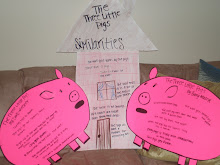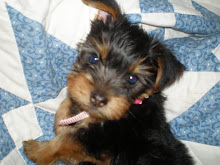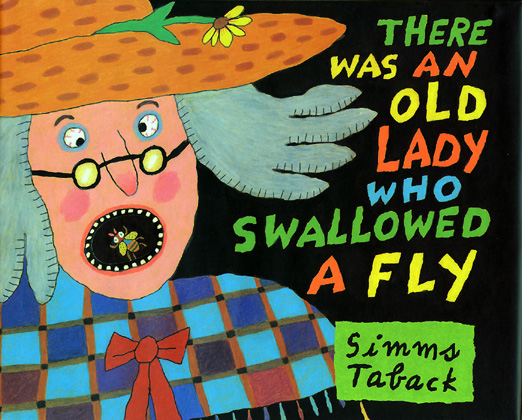Moser, Barry
Little, Brown and Company, 2001
All ages
This is the story of the three little pigs. This story is closer to the real Three Little Pigs. In the story the pigs each want to build their own house out of wood, straw and brick. They ask a human for the supplies. A wolf comes along and blows down the house with the straw. The second pig builds his house out of sticks. The wolf came along, knocked it down and gobbled the little pig up. The third and smartest pig built his of brick. The pig outsmarts the wolf by rolling down a hill in a butter churn. The wolf was angry and tried to jump down the chimney but there was a hot pot of water that he fell into, after this the little pig had a great dinner!
I really enjoyed reading this book. This was one of my favorite stories when i was a little girl, that is why i chose to read it. My favorite part is at the end where the pig is eating his soup and he has on wolf slippers! I thought that this was a funny thing to add.
I would use this in my classroom when comparing/contrasting tales. I made a venn diagram for this book and i could use it in my classroom as an example!
Tuesday, March 18, 2008
The Three Pigs
Wiesner, David
Clarion Books, 2001
Caldecott Honor
All Ages
This book is about the story of the three little pigs. There were three little pigs who all wanted to build a house one from wood, one from straw, and one of brick. A wolf came along and blew down the house with wood and sticks. The pigs got away by flying off the page into another story, where there was a dragon. The dragon came back to the brick house with the pigs and they outsmarted the wolf and ate him for dinner.
I really enjoyed reading this book because it was such a traditional tale with a twist. In the real story the pigs do not go into another story to get away from the wolf. Also the pictures are so cool they look like they have demensions. Some of the pigs look like they are coming off of the page! The pictures in this book are unlike any I have ever seen. He makes the illustrations literally look like they are coming off of the page. This is a great way to keep readers engaged and this creative method is deffinately Caldecott worthy. He gives such a great twist to the original Three Little Pigs and makes it fun. My favorite part of the story is when the pigs make a paper airplane and fly into another story to find the dragon. I thought that this was such a creative solution. David Weisner used watercolor in his illustrations and he really made the pictures pop. My favorite page is where the wolf is at the doorstep and the dragon is popping out and the pigs are by the dragons side. The wolf looks so scared and it literally looks like he is just coming off of the page.
I would use this in my classroom when talking about traditional tales. I want children to see different perspectives on the literature they are reading and this book really does that! Also you could look at the artist perspective of the story. The way he places the characters on the page really make them pop out at you. You could do an activity with kids to help teach them to illustrate their own books using this method.
Clarion Books, 2001
Caldecott Honor
All Ages
This book is about the story of the three little pigs. There were three little pigs who all wanted to build a house one from wood, one from straw, and one of brick. A wolf came along and blew down the house with wood and sticks. The pigs got away by flying off the page into another story, where there was a dragon. The dragon came back to the brick house with the pigs and they outsmarted the wolf and ate him for dinner.
I really enjoyed reading this book because it was such a traditional tale with a twist. In the real story the pigs do not go into another story to get away from the wolf. Also the pictures are so cool they look like they have demensions. Some of the pigs look like they are coming off of the page! The pictures in this book are unlike any I have ever seen. He makes the illustrations literally look like they are coming off of the page. This is a great way to keep readers engaged and this creative method is deffinately Caldecott worthy. He gives such a great twist to the original Three Little Pigs and makes it fun. My favorite part of the story is when the pigs make a paper airplane and fly into another story to find the dragon. I thought that this was such a creative solution. David Weisner used watercolor in his illustrations and he really made the pictures pop. My favorite page is where the wolf is at the doorstep and the dragon is popping out and the pigs are by the dragons side. The wolf looks so scared and it literally looks like he is just coming off of the page.
I would use this in my classroom when talking about traditional tales. I want children to see different perspectives on the literature they are reading and this book really does that! Also you could look at the artist perspective of the story. The way he places the characters on the page really make them pop out at you. You could do an activity with kids to help teach them to illustrate their own books using this method.
Monday, March 17, 2008
Swamp Angel
Isaacs, Anne
Zelinsky, Paul
3-5
Penguin Putnam Books for Young Readers, 2006
Caldecott Award
Swamp Angel is about a girl named Angelica Longrider. When she was born she was taller than her mother. She was born in Tennesee. There was a bunch of wagons that were stuck in a swamp and she came to help them get their wagons out. She simply picked them up and sat them back on the road. The people thought that she was an angel, and then began calling her Swamp Angel. Then there was a huge bear loose. They called him the Thundering Tarnation. All the men set out to capture the bear and Angelica was the only female. She restled with the bear for days. She threw him into the sky, and fought him in a lake. Finally a tree landed on him and killed the bear. The whole town had a feast, and she kept his pelt as a rug, and moved to Montana.
I really enjoyed reading this book. I liked how the author talked the way southern people talked. I liked how he incoportated the Montana prarie grass, and the star constellations as well. Those were really neat connections. And of course the pictures were my favorite because i always love the illustrations. These illustrations really set the mood for the story.
I would use this in my classroom. You could use it when talking about different parts of the US, and look at the dialect that is used. I also like how as a girl she stood up to those men. I think that it is important to teach young girls that they can do anything boys can do. Overall I really enjoyed this book and look forward to sharing it with my class.
Zelinsky, Paul
3-5
Penguin Putnam Books for Young Readers, 2006
Caldecott Award
Swamp Angel is about a girl named Angelica Longrider. When she was born she was taller than her mother. She was born in Tennesee. There was a bunch of wagons that were stuck in a swamp and she came to help them get their wagons out. She simply picked them up and sat them back on the road. The people thought that she was an angel, and then began calling her Swamp Angel. Then there was a huge bear loose. They called him the Thundering Tarnation. All the men set out to capture the bear and Angelica was the only female. She restled with the bear for days. She threw him into the sky, and fought him in a lake. Finally a tree landed on him and killed the bear. The whole town had a feast, and she kept his pelt as a rug, and moved to Montana.
I really enjoyed reading this book. I liked how the author talked the way southern people talked. I liked how he incoportated the Montana prarie grass, and the star constellations as well. Those were really neat connections. And of course the pictures were my favorite because i always love the illustrations. These illustrations really set the mood for the story.
I would use this in my classroom. You could use it when talking about different parts of the US, and look at the dialect that is used. I also like how as a girl she stood up to those men. I think that it is important to teach young girls that they can do anything boys can do. Overall I really enjoyed this book and look forward to sharing it with my class.
Lon PoPo
Young, Ed
Penguin Putnam Books, 1996
Multicultural
All ages
Folklore
The story Lon PoPo is the chinese version of Little Red Riding Hood. It is about three sisters, Shang, Tao, and Paotze. Their mother leaves them to go visit their grandmother for her birthday. The wolf sees her leave the children and goes to them. He knocked on the door and pretended that it was their grandmother. The children let him him, thinking that it is their grandmother. They are holding a candle which the children keep blowing out. He told them he was hairy because he brought hemp to weave a basket. Then he said he had spikes on his hands to make shoes. They then catch on and the oldest child decides to trick him. She asks him if he likes Ginko berries and he asked what they were. She told him that with one bite you could live forever. They get a basket and some rope and try to lift him up to the top of the tree and they drop him three times. On the third time he falls to the ground and dies, and the children are safe.
I liked this book, but I am so used to the other version of Little Red Riding Hood. I really enjoyed the pictures and thought that they were so beautiful. I remember when i was little this story used to really scare me but i think that it is good to introduce different versions of traditional literature to children. This is the first time that I have experienced another version.
I think in the classroom you could use this to learn about other cultures. Little Red Riding Hood is such a traditional tale for young american children and i think that they w ould be excited to learn about other versions of the story. You could also use the venn diagram which we have been working on to compare and to contrast.
Penguin Putnam Books, 1996
Multicultural
All ages
Folklore
The story Lon PoPo is the chinese version of Little Red Riding Hood. It is about three sisters, Shang, Tao, and Paotze. Their mother leaves them to go visit their grandmother for her birthday. The wolf sees her leave the children and goes to them. He knocked on the door and pretended that it was their grandmother. The children let him him, thinking that it is their grandmother. They are holding a candle which the children keep blowing out. He told them he was hairy because he brought hemp to weave a basket. Then he said he had spikes on his hands to make shoes. They then catch on and the oldest child decides to trick him. She asks him if he likes Ginko berries and he asked what they were. She told him that with one bite you could live forever. They get a basket and some rope and try to lift him up to the top of the tree and they drop him three times. On the third time he falls to the ground and dies, and the children are safe.
I liked this book, but I am so used to the other version of Little Red Riding Hood. I really enjoyed the pictures and thought that they were so beautiful. I remember when i was little this story used to really scare me but i think that it is good to introduce different versions of traditional literature to children. This is the first time that I have experienced another version.
I think in the classroom you could use this to learn about other cultures. Little Red Riding Hood is such a traditional tale for young american children and i think that they w ould be excited to learn about other versions of the story. You could also use the venn diagram which we have been working on to compare and to contrast.
Saturday, March 1, 2008
Baseball Saved Us
Mochizuki, Ken
Lee, Dom
Picture book, Multicultural, historical fiction
Lee and Low Books Inc, 1993
Ages 3rd grade and up
This book is about a young Japanese boy who was living in an internement camp in America during WW2.. One day his father said that he was sick of living there and that he was going to build a baseball field to give them something to do. He described himself as being smaller than all of the other kids. He was the last to be picked and the last to go. Many people made fun of him, calling him names and taunting him. It describes his situtation briefly when the Japanese bombed Pearl Harbour and they had to relocate to an internment camp. He described the camp as being hot and he also talked about the dust storms. They lived in barracks. He talks about how back at home they were always so busy, but there they had nothing to do do. This is when his father decided to get some shovels and build a baseball field. When he first started to play he was not very good, but his father kept telling him to keep trying. During the last game he got a very important hit. He took all of his anger and used it when hitting the ball. His teammates were so proud of him and he felt like he belonged. When baseball season came back around he was still the smallest boy . He played with people that were not like him, whites. Poeple yelled at him and called him A Jap and this really hurt his feelings. People were yelling at him and telling him he couldnt do it and once again he took all of that anger, swung the bat and the ball flew.
I really enjoyed reading this book. I think that it is a wonderful way to talk about what happend with younger children. It shows that even though people are telling you you cant do something you can if you believe in yourself. It also shows a good example of how to manage anger. Many children have anger but are unsure how to get it out and i think things like sports and writing and art are good ways. I really loved the illustrations as well. It says in the book that the illustrations were made from beeswax on paper, then scratching out the images and finally adding oil paint for color. That is unbelievable, i almost thought that the illustrations looked like colored pencil.
In the classroom you could use this book for many lessons. You could use it to teach about the Japanese internment camps. There were alot of connections i made between this book and Weedflower, the stories are so similiar. They both talk about being lonely, having a lot of time to spare and many other things like living conditions. It would be good to use both of these books together. Also you could talk about learning to manage your anger in healthy ways. You could even make a lesson out of the illustrations because they were so beautiful, and i have never heard of scratching of beeswax and then adding water color, that would be a really neat topic to research.
Lee, Dom
Picture book, Multicultural, historical fiction
Lee and Low Books Inc, 1993
Ages 3rd grade and up
This book is about a young Japanese boy who was living in an internement camp in America during WW2.. One day his father said that he was sick of living there and that he was going to build a baseball field to give them something to do. He described himself as being smaller than all of the other kids. He was the last to be picked and the last to go. Many people made fun of him, calling him names and taunting him. It describes his situtation briefly when the Japanese bombed Pearl Harbour and they had to relocate to an internment camp. He described the camp as being hot and he also talked about the dust storms. They lived in barracks. He talks about how back at home they were always so busy, but there they had nothing to do do. This is when his father decided to get some shovels and build a baseball field. When he first started to play he was not very good, but his father kept telling him to keep trying. During the last game he got a very important hit. He took all of his anger and used it when hitting the ball. His teammates were so proud of him and he felt like he belonged. When baseball season came back around he was still the smallest boy . He played with people that were not like him, whites. Poeple yelled at him and called him A Jap and this really hurt his feelings. People were yelling at him and telling him he couldnt do it and once again he took all of that anger, swung the bat and the ball flew.
I really enjoyed reading this book. I think that it is a wonderful way to talk about what happend with younger children. It shows that even though people are telling you you cant do something you can if you believe in yourself. It also shows a good example of how to manage anger. Many children have anger but are unsure how to get it out and i think things like sports and writing and art are good ways. I really loved the illustrations as well. It says in the book that the illustrations were made from beeswax on paper, then scratching out the images and finally adding oil paint for color. That is unbelievable, i almost thought that the illustrations looked like colored pencil.
In the classroom you could use this book for many lessons. You could use it to teach about the Japanese internment camps. There were alot of connections i made between this book and Weedflower, the stories are so similiar. They both talk about being lonely, having a lot of time to spare and many other things like living conditions. It would be good to use both of these books together. Also you could talk about learning to manage your anger in healthy ways. You could even make a lesson out of the illustrations because they were so beautiful, and i have never heard of scratching of beeswax and then adding water color, that would be a really neat topic to research.
Subscribe to:
Posts (Atom)
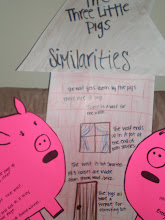
By Barry Moser
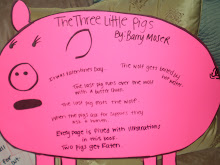
By David Wiesner
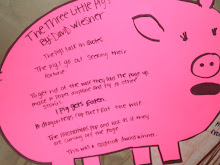
The Three Little Pigs
